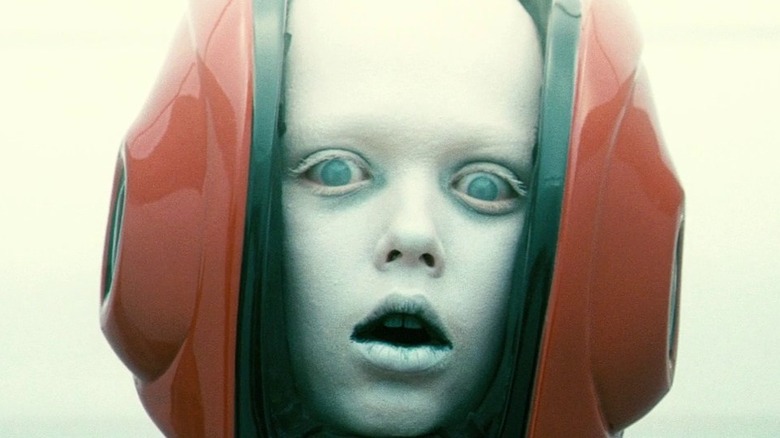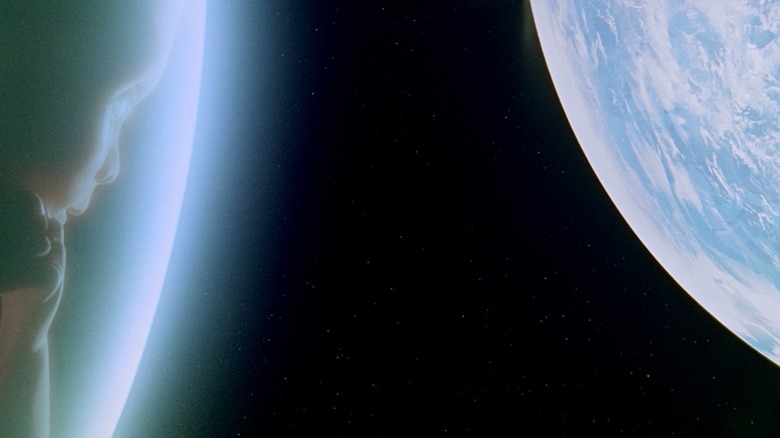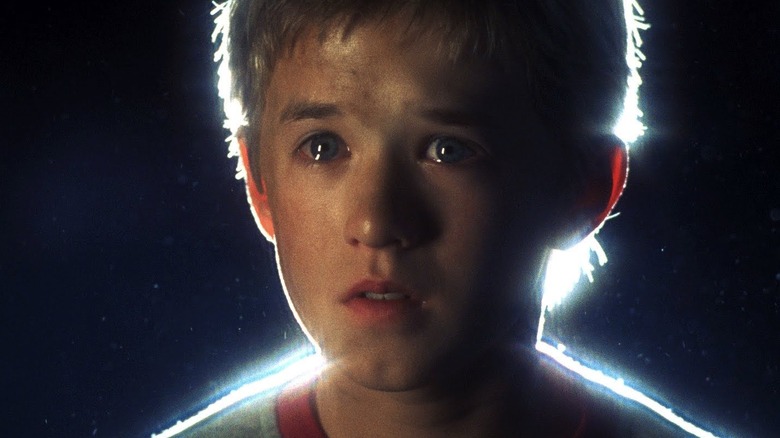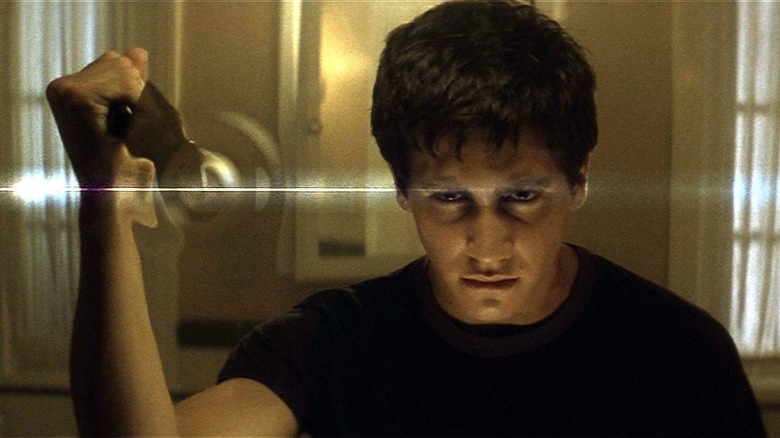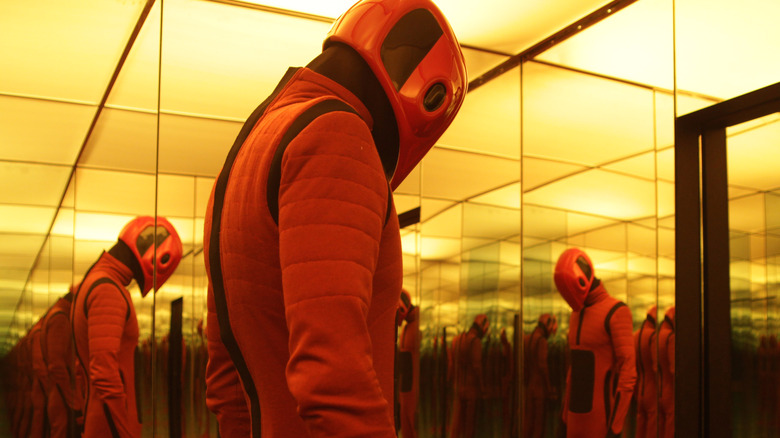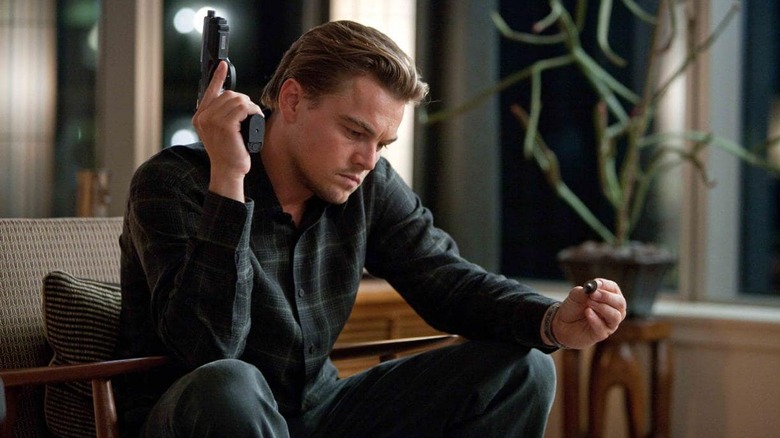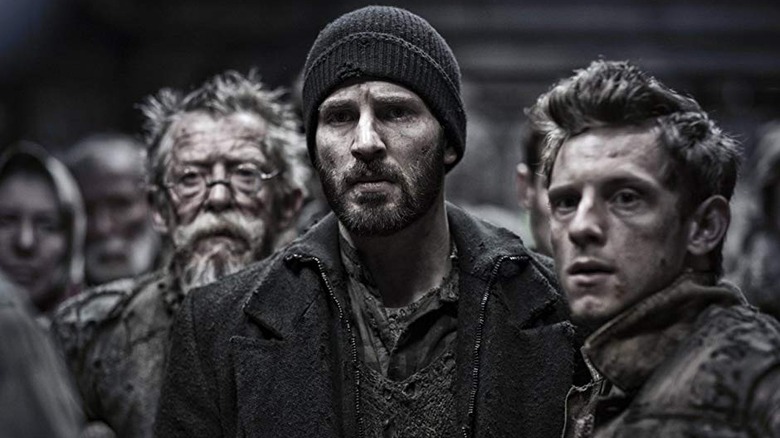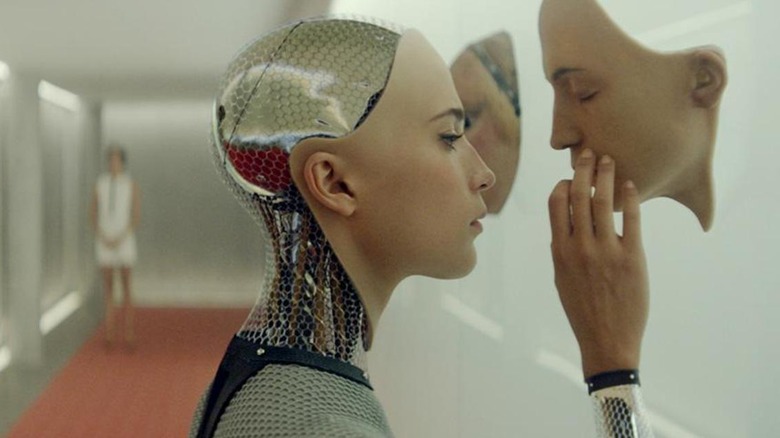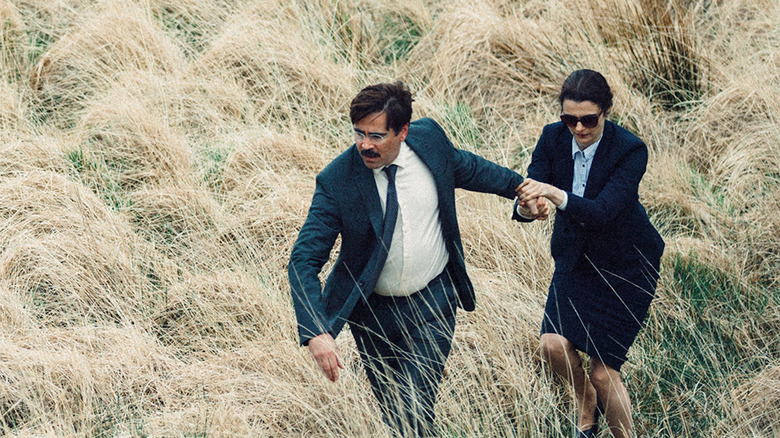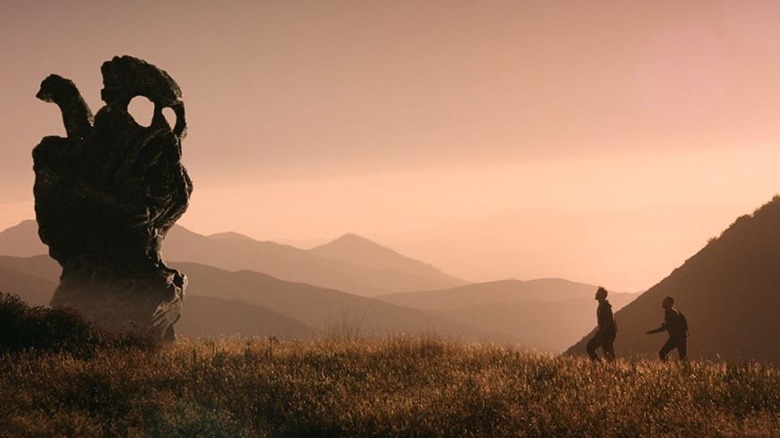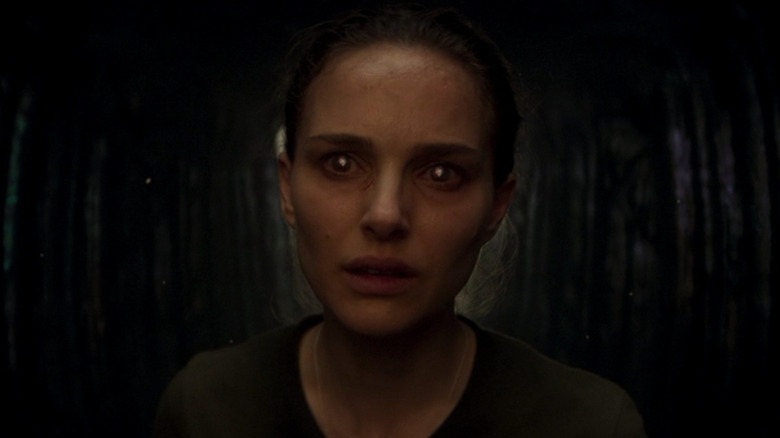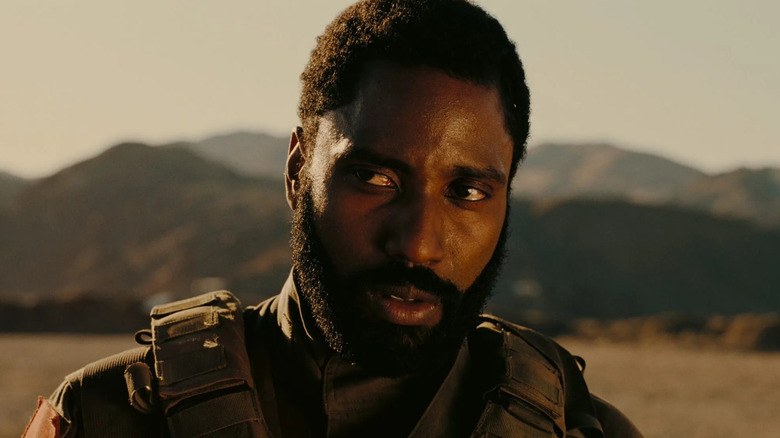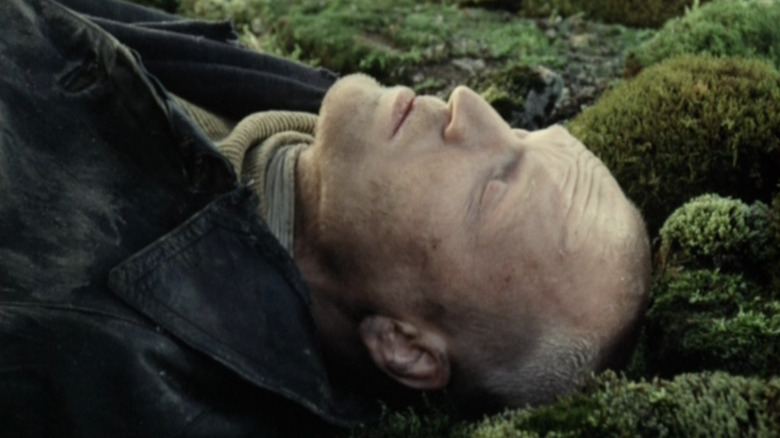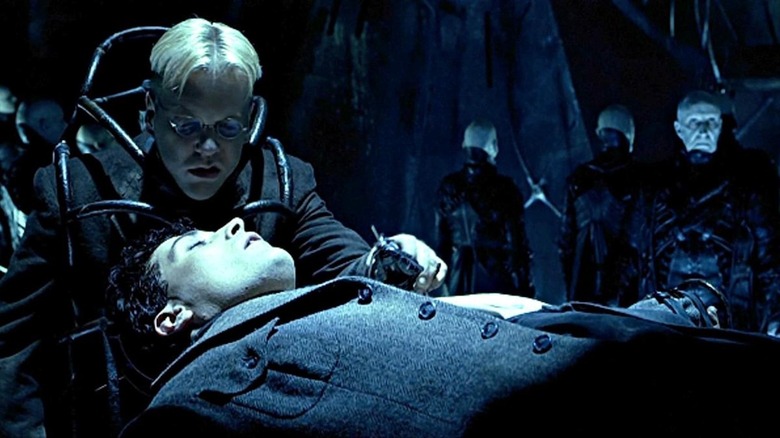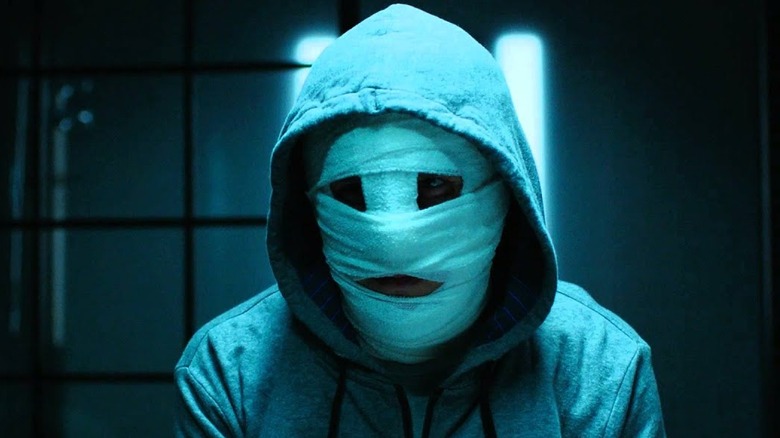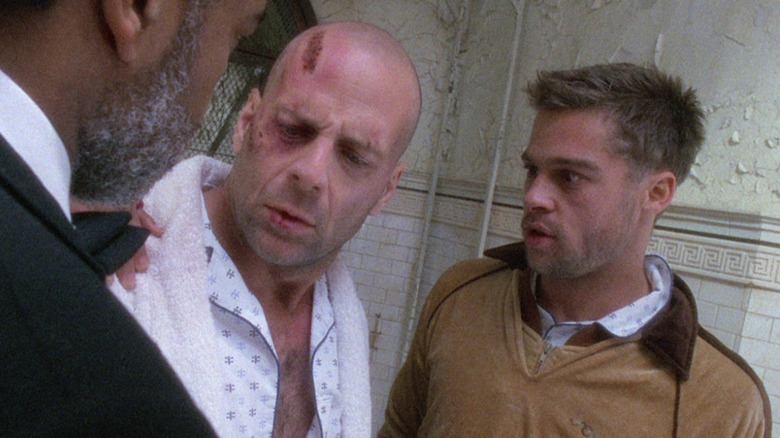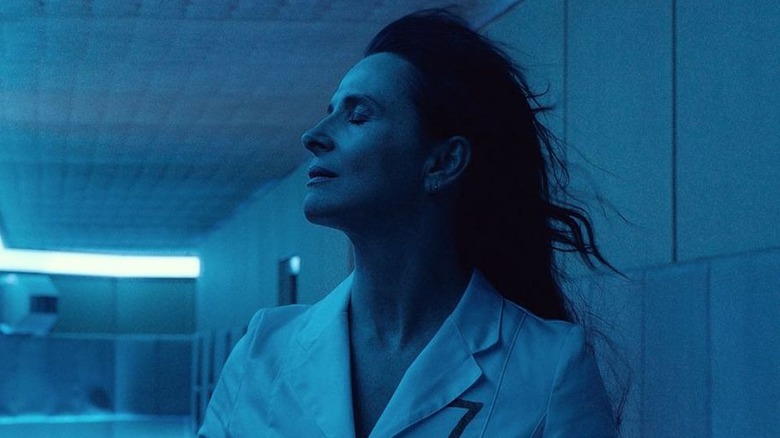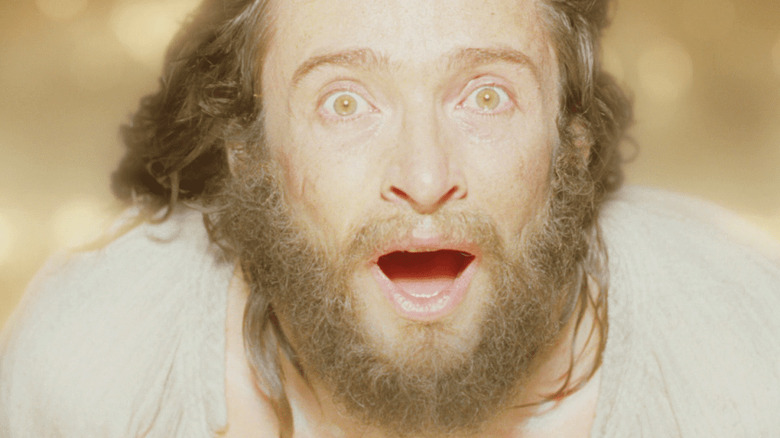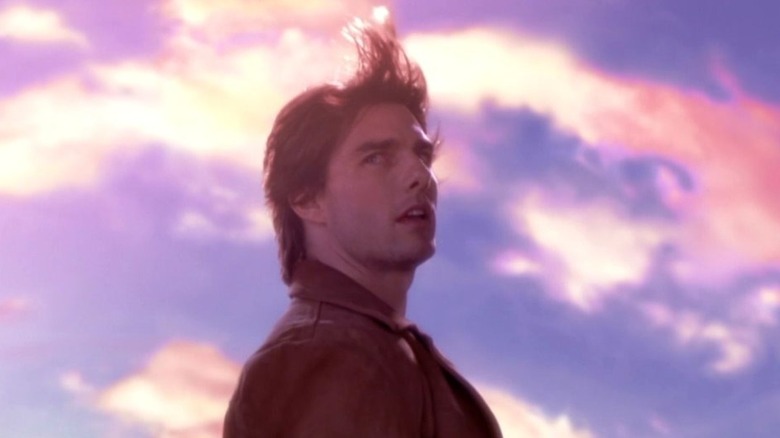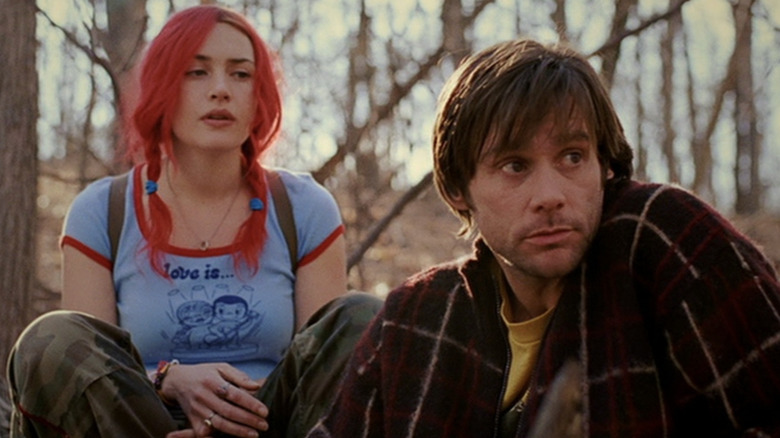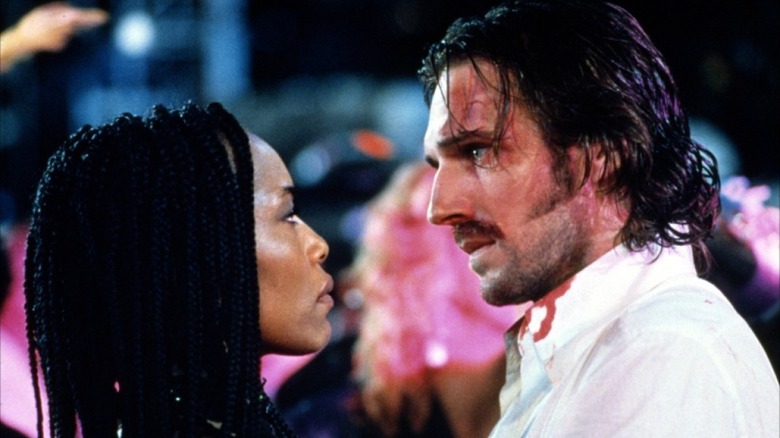Sci-Fi Movies People Still Don't Understand
In 1902, Georges Melies released A Trip to the Moon, and ever since then, science fiction has been one of the most beloved genres in all of cinema. In fact, if you look at the highest-grossing movies, a lot of them involve futuristic technology or take place on alien planets. Moviegoers love sci-fi because it allows them to explore new worlds and grapple with exciting concepts like time travel and artificial intelligence. However, when you're dealing with wormholes and alien life forms, things are bound to get complicated. While some sci-fi films are pretty easy to grasp (think Star Wars or Jurassic Park), others are a little more complicated. Maybe that's because these movies are intentionally ambiguous, perhaps it's because the director made a controversial decision, or maybe the story is so mind-bending that it's just plain impossible to wrap your brain around. From space epics to post-apocalyptic adventures, these are the sci-fi movies that people still don't understand.
The mysterious Star Child of 2001: A Space Odyssey
Stanley Kubrick's 2001: A Space Odyssey is one of the all-time classic sci-fi films. In fact, it's one of the greatest movies ever made. The film pushed the boundaries of special effects, took sci-fi from B-movie shlock to serious art, and made everyone afraid of killer computers. The movie also gained a reputation as a great film to drop acid to, thanks to the infamous star gate sequence.
After escaping the clutches of Hal 9000, astronaut Dave Bowman (Keir Dullea) is sucked into an LSD tunnel right outside Jupiter. He's assaulted with all sorts of lights and crazy colors before winding up in cold, soulless hotel room. In just a matter of minutes, Bowman turns into an old man, and that's when a black monolith appears at the foot of his bed. These monoliths have been turning up the entire movie, sparking new stages of evolution whenever they appear. And when Dave reaches out to touch the big black obelisk, he turns into a glowing space fetus.
This magical floating baby is known as the Star Child, and in the film's final shot, it floats out into the galaxy, looking down at Earth. That Star Child has caused a whole lot of head-scratching over the years. Did Dave literally transform into an alien infant? Is the Star Child symbolic of humanity's next stage in evolution? Or could it mean something else altogether? We wish we could come up with the definitive answer, but as Hal would say, "I'm sorry, Dave. I'm afraid I can't do that."
The controversial ending of A.I. Artificial Intelligence
A.I. Artificial Intelligence is a thoroughly depressing affair. This is a film where Haley Joel Osment breaks down crying because his "mom" abandons him in the woods. Granted, Osment is playing a lifelike android named David, but still, you can't just toss a heartbroken "mecha" into the wild. After all, the world is cruel to little androids. Poor David is bullied by human kids, sees his fellow robots ripped apart, and eventually finds himself stuck at the bottom of the ocean, desperately wishing he could become a real boy. It's a wish that will never come true.
And then there's that ending.
Two thousand years later, David is rescued by evolved A.I. The creatures take pity on the little mecha, and using advanced tech, they give David one last day with his mother (Frances O'Connor). And that's how the movie ends, with David cuddling his mom, happy at last. Sci-fi fans, however, were outraged. Many people think the ending is too schmaltzy, and they blame director Steven Spielberg. Originally, A.I. was a Stanley Kubrick project, so naturally, many assume Spielberg screwed up Kubrick's dark project by tacking on the sappy finale.
But as Spielberg points out, the whole "David gets to spend one last day with his mother" thing was actually Kubrick's idea. More importantly, this isn't a happy ending. The evolved mechas are granting David's wish because they're about to shut him down forever. They're going to kill this little kid, and we're watching his final fantasy (with a fake mother, no less) before he's put down. If that's not a Kubrick ending, then we don't know what is.
The freaky time travel physics of Donnie Darko
Richard Kelly's cult classic Donnie Darko hit theaters in 2001, but fans are still trying to solve this incredibly complex sci-fi flick. The plot follows the titular Donnie (Jake Gyllenhaal), a troubled teen whose life is saved by a six-foot-tall rabbit named Frank. As if that isn't crazy enough, the film soon introduces the concept of time travel and alternate dimensions, and it would take endless viewings to figure out the crazy physics at play here. We know Donnie has to stop an apocalypse, but what exactly does that have to do with wormholes? How do deceased characters come back to life, what's going on with that demonic bunny, and why is Donnie wearing that stupid human suit? It's all so complicated that Kelly released a Director's Cut to help fans put the puzzle pieces together. Donnie Darko is a movie that demands rewatch after rewatch, and while we have a good idea of what's really going on, there's no denying it's a mad movie.
The New Age acid trip of Beyond the Black Rainbow
Before introducing the world to the Cheddar Goblin, director Panos Cosmatos broke onto the cinematic scene with Beyond the Black Rainbow, a psychedelic nightmare of a movie featuring a telekinetic girl, a slasher scientist, and a creepy creature with a doll-like face. It's a mind-bending movie that's been compared to films like El Topo and Eraserhead, and according to Cosmatos, the film's screenplay is only 11 pages long. In other words, this is a movie that takes its sweet time, drowning audiences with drug-fueled images that make you wonder if you're watching a film or going on an acid trip. The movie prompts so many questions — like what's really happening at the Arboria Institute? What's up with that glowing crystal? What is that horrific, crawling zombie? And what exactly happens to the villainous Dr. Nyle (Michael Rogers) after he goes beyond the black rainbow? By the time you come down from this incredibly disturbing trip, you'll either immediately want more, or you'll have completely lost your mind.
The controversial final shot of Inception
Directed by Christopher Nolan, Inception is a mind-bending movie where cities fold on top of each other, trains appear out of nowhere, and Tom Hardy can morph into Tom Berenger. In other words, it's a movie about the power of dreams. It takes place in the subconscious, where rules can be bent and mental barriers manipulated, but for all its incredible imagery, Inception sparked so much conversation because of a simple spinning top.
The plot of this sci-fi blockbuster follows a group of thieves, led by the enigmatic Dominick Cobb (Leonardo DiCaprio), as they try to implant an idea in the mind of a young business heir. If Cobb can complete the mission, he'll have his murky past erased, and he'll finally get to return to the U.S. and see his kids again. And wouldn't you know it? The mission is a success, and in the film's final moments, Cobb is reunited with his children... maybe.
There's actually a good chance that Cobb might be asleep — stuck in limbo for the rest of his life. Everything depends on that infamous top. If Cobb is in the real world, it will topple over eventually. But if he's still asleep, it will keep on spinning forever. The movie cuts right as the top starts to wobble, prompting endless debate ever about Cobb's fate. But according to Christopher Nolan, it's not such a big deal if the top falls over or not. As the director explained, the important thing for Cobb is that he's back with his kids. Whether this is reality or it's all in his head, the only thing that matters is that it's real for Cobb.
The fate of humanity in Snowpiercer
Directed by Bong Joon-ho, Snowpiercer is set in a post-apocalyptic future where the Earth has turned into a desolate ice cube. The last remnants of humanity are living on a train that's continually circling the globe. Unfortunately, the train is sharply divided by class, with the proletariat starving in the back and the bourgeoisie partying in the front. Eventually, the peasants stage a revolt, which leads to Captain America destroying the train and killing everybody onboard.
Well, almost everybody.
Two children emerge from the rubble of the train — a little boy and a teenage girl — and as they step into the snow, they spy a nearby polar bear. Everybody aboard the train has long believed it was too cold outside for anything to survive. But here is a living, breathing creature, thriving in the great outdoors... so is that good news or bad news? Well, a lot of film fans believe this means the end of humanity. How are these kids who've spent their whole lives in a locomotive going to survive this freezing cold wilderness? Especially when that polar bear looks like he might enjoy a few human-sized snacks?
However, Joon-ho has a much more upbeat take on the film's finale. Speaking with Vulture, the filmmaker described the ending as "very hopeful," since the two kids will eventually "spread the human race." In other words, they're the new Adam and Eve. As for the polar bear, it's a symbol that life will go on, that the Earth is thawing out and humanity can still survive. Well, if they don't wind up as a bear's breakfast, anyway.
Ava's shocking choice in Ex Machina
Ex Machina is a creepy film that looks at what might happen when humanity finally creates artificial intelligence. And what might happen? Nothing good. That's a lesson that Caleb (Domhnall Gleeson) learns the hard way after he's invited to participate in an advanced Turing test by billionaire tech genius Nathan (Oscar Isaac). The programming prodigy wants Caleb to see if his imprisoned android, an A.I. named Ava, is capable of independent thought. The only hitch is that Ava looks like Alicia Vikander, and Caleb starts to fall for her.
Ava and Caleb seem to grow close, and after realizing Nathan is a monster who's creating female androids for his own sick gratification, Caleb decides to break Ava loose. He hopes they can run away together, and Ava seems totally cool with Caleb's plan. But once she's free, she murders Nathan and locks up Caleb, leaving him to die as she sets out into the real world. However, her decision to betray Caleb left a lot of movie fans baffled. Why kill such a nice guy?
Well, Caleb might not have been as glaringly evil as Nathan, but he's not exactly a saint. Caleb only treats Ava like a human once he starts falling in love with her. Even though he's more polite, he views Ava like an object, just like Nathan does. He only decides to help her escape after Ava flirts with him and makes him feel special. As noted essayist FilmCritHulk points out, there's no way Ava wants to spend her life with another man who wants to possess her. She's tired of being a slave, so it's time to fight back.
Colin Farrell's disgusting decision in The Lobster
Finding love is hard, but when you've only got 45 days to find a mate or be morphed into an animal, that makes things a lot more difficult. Unfortunately for poor David (Colin Farrell), if he doesn't find a partner in a few weeks, he'll be tossed into a mysterious machine and turned into a lobster.
However, things start looking up when he meets the Shortsighted Woman (Rachel Weisz). In this society, partners have to share a physical similarity, and since they both suffer from myopia, it seems they're a match... until Rachel is blinded. This leaves the lovers in a tricky situation. If they want to make this work, David will have to blind himself too. So the couple heads to a restaurant, where the Shortsighted Woman waits at a table as David heads to the bathroom, steak knife in hand.
In one of the scariest scenes in a non-horror film, David stands in front of mirror, holding the knife centimeters away from his eyeball. But before we can discover if he gouges his eyes out, the film cuts to the Shortsighted Woman sitting at her table. She waits and waits for David to return, and that's when the film goes black, leaving audiences to wonder if David did the bloody deed.
Well, not even the cast and crew know. Speaking with Entertainment Weekly, Farrell revealed that director Yorgos Lanthimos and screenwriter Efthymis Filippou never came up with an answer for the film's ending. As for himself, Farrell can see it going either way. "Honest to God, part of me thinks he does it. Then part of me thinks that when the camera cuts back to Rachel Weisz, I'm already in a f*****g Uber, heading down the road as fast as I can." The actor also suggested that maybe David actually faked blinding himself, so he could be with his lover and still keep his eyesight. Whatever your interpretation, it probably says a lot about the way you view romance.
The monstrous mythology of The Endless
Written and directed by Justin Benson and Aaron Moorhead, The Endless follows two brothers (played by the filmmakers) who escaped a UFO cult when they were younger, but a strange video lures them back to the group. Once they arrive, freaky things start happening, and they get the feeling there's something evil in the darkness.
By the time the credits roll, The Endless has posed a lot of complicated questions. What's up with the entity and the time loops? What's with those freaky statues? And what are the dudes from Resolution doing here? Well, the invisible demon haunting our heroes is a stand-in for horror movie audiences who like their stories to have dark endings. And as it turns out, the creature drew the brothers back to the cult in hopes of trapping them in a time loop. This particular desert is crowded with different loops, some which last seconds and others which stretch on for decades. And if you die in the loop or submit yourself to the beast, you'll be trapped forever.
That's why the cult members look so young. They've been repeating the same cycle every ten years. And at the end of each loop, the entity tears them to shreds, and they start over again. It's all part of the creature's need for scary stories with violent endings. (That's why some characters keep killing themselves. It's a better option than what the entity will do to you.) The Endless also takes place in the same universe as Resolution, so the characters from the 2012 film get an extended cameo here. They're trapped in their own loop, desperately trying to get out.
As for those monuments — the totem pole, the monolith, the dragon statue — those all represent the evil entity. They were constructed by victims stuck in these loops, and they're meant to express how these poor people viewed the demon. And judging by the age of some of these sculptures, it seems like this inter-dimensional creature has been trapping people for a very long time.
Natalie Portman's enigmatic eyes in Annihilation
Whether it's the sight of a skull bear or slithering intestines, Annihilation is a movie that sticks in your mind. But even more compelling than a gigantic sharkagator is the film's ambiguous ending. After heading into the Shimmer — an ever-growing electromagnetic wave that mixes and matches DNA — a biology professor named Lena (Natalie Portman) encounters a metallic humanoid that tries to copy her likeness. Using a grenade, Lena kills the doppelgänger and burns down the Shimmer, but while she's saved the world, that doesn't mean it's smooth sailing for our hero.
Lena's whole reason for heading into the Shimmer was to discover what happened to her husband, Kane (Oscar Isaac). He's a soldier who went MIA after heading into the world's freakiest light show, and then a year later, he suddenly appeared out of nowhere, deathly ill. Hoping to save his life (and assuage some guilt), Lena ventures into the Shimmer to figure out what's going on, only to learn her real husband has killed himself. The guy back at the hospital is just a doppelgänger, much like the one that tries to take Lena's place.
However, there's something odd about the Lena who finally escapes the Shimmer. When she touches a glass of water, the liquid starts acting all weird. When she hugs her clone husband, we see the color in her eyes dance and wave, much like the lights in the Shimmer. Did the real Lena make it back home? Was she replaced by the doppelgänger somewhere during their struggle? Or perhaps the Shimmer altered her DNA and turned her into something new. Whatever happened, Lena is a new person, forever changed by literally confronting herself.
Tenet's mind-bending Time Inversion scenes
Christopher Nolan's mind-bending 2020 sci-fi flick "Tenet" just might be the filmmaker's most confusing movie yet. Met with lukewarm reception, "Tenet" is a high-concept puzzle box, which is more interested in giving the viewer clues to solve it rather than answers.
The Protagonist (John David Washington) is a CIA agent, who finds a mysterious artifact during a mission. The artifact gets stolen from him, and he's recruited by a time-traveling organization called Tenet to retrieve it. The Protagonist and his handler Neil (Robert Pattinson) travel the globe to recover the artifact but nothing — and no one — is as it seems. That sounds straightforward enough, but things are never so simple in a Christopher Nolan movie, and the ending of "Tenet" is one of his most confounding.
The film's core concept is "time inversion," which means that the entropy or energy of objects from the future moves backwards, so things from the future get brought into the past. Those in the present move forward, while the future moves backwards (in the present). To achieve this effect of two movements at the same time, Nolan shot the time inversion action sequences twice — one forwards and the other with the actors moving backwards (via The Face).
Getting your head around the concept of time inversion is the first key to unlocking the rest of "Tenet." Most viewers are bound to get lost their first time around, as the movie breaks down linear time to render it a circle. So, even the movie's defenders say it takes another trip around (or should we say back and forth?) to really get it to click.
The philosophical ambiguity of Stalker
"Stalker" is a classic, but by today's standards, it is a slow movie. Watching Andrei Tarkovsky's 1979 cerebral work of post-apocalyptic sci-fi is a test of patience. But for those who have stuck with it, the reward has been great, as seen in its influence: Alex Garland's "Annihilation" was aesthetically inspired by it, while the popular "S.T.A.L.K.E.R." franchise is a video game adaptation of the film (via The New York Review). Over the years, many people have watched this movie and walked away with different stabs at its meaning. A deeply interpretive film, "Stalker" is as confounding as it is profound.
Based on Arkady and Boris Strugatsky's novella "Roadside Picnic," three men — the writer (Anatoly Solonitsyn), the professor (Nikolai Grinko), and the Stalker (Alexander Kaidanovsky) — go into the radioactive "Zone," which contains a mythical wish-granting room. The trio ventures through a dangerous land of paranormal anomalies and unexplained phenomena, all while philosophically sparring with each other and exploring their motivations for the journey.
When they finally reach the Room, however, there is an inexplicable anti-climax, as the three men sit in silence. What happens inside the room and the significance of their journey is left ambiguous. What exactly is the Zone and how has it changed the people who dare enter it? The final shots of the movie show that the Stalker's daughter has now gained superhuman powers, which are implied to be a result of his journey. This question and others are asked from the start of "Stalker," and its lack of answers still sparks vigorous discussion (via Reddit).
The truth of the Dark City
A year before "The Matrix" lit the world on fire, the sci-fi noir "Dark City" similarly used cyberpunk aesthetics to explore the concepts of personal identity and individuality. John Murdoch (Rufus Sewell) wakes up in a hotel with amnesia and a corpse next to him, and he starts running from the police for this crime that he doesn't remember. He's soon pursued by mysterious men in trench coats known as the Strangers, as he attempts to reassemble his identity.
He enlists the help of the enigmatic Dr. Daniel Schreber (Kiefer Sutherland), who reveals that The Strangers are an alien hive mind and Murdoch is an experiment gone wrong. In a final attempt to find his family, Murdoch literally tears upon reality and discovers the titular city is a singular habitat floating in space. The entire city is a space station where The Strangers experiment on humans. After utilizing his powers to defeat The Strangers, Murdoch opens a door to a new reality, where he can live happily with his wife and re-create the world in his image.
This massive twist turns its protagonist into a God in the same way as "The Matrix," but "Dark City" is a stranger — and equally as brilliant – film. The ending leaves viewers wondering if the new world Murdoch creates is actually real. And what will Murdoch's world become? Will it be fantasy for him to live out for eternity or another society that crumbles like the dark city? Either answer has its own terrifying implications.
The paradox in Predestination
If you are familiar with a predestination paradox or causal loop, you might have some idea of where this Ethan Hawke sci-fi thriller is headed. "Predestination" is based off of Robert A. Heinlein's 1959 science fiction short story "'–All You Zombies–'." The 2014 sci-fi puzzle stars Hawke as Agent Doe, a disfigured time-traveling agent, who doubles as a barkeep after a failed attempt to stop the bomber that wounded him.
One day in 1970, Agent Doe meets John (Sarah Snook), who reveals that he was born an intersex female named Jane and had a child, who was stolen by an unknown man. Complications during birth led to forced gender reassignment surgery, so Jane began living as John. Agent Doe takes John back in time to 1963 to get revenge on the man who created this situation, only to realize that John is the person who got Jane (a.k.a. himself) pregnant. So, Agent Doe takes Jane's baby further back in time to 1945, and the child grows up into Jane.
This is the predestination paradox and it only gets more complicated until by the end, it is revealed the movie is about a single character. The agent and the bomber are also the same person as John/Jane/the baby. After learning he is the same person, the agent kills the bomber and tries to close his own loop.
And then "Predestination" ends, leaving us to imagine John's endless nightmare and wonder about the logic and existential questions behind all of this. Although forget speculation about deeper meaning — for many Reddit users, it feels difficult to even understand what happened in the movie at all.
The ending of 12 Monkeys
Inspired by the groundbreaking French short film "La Jetée," visionary sci-fi director Terry Gilliam brings a fresh set of eyes to an old fashioned time loop tale in "12 Monkeys." The killer cast and gorgeous production design are enough to get viewers to still return this 1995 classic, even if the ending is a bit mind-boggling.
In a post-apocalyptic 2035, James Cole (Bruce Willis) is a prison inmate, who gets sent back in time to stop the virus that destroyed humanity. He travels back to 1996 to track down the source of the virus, but he is continuously haunted by dreams of a little boy seeing a man shot at an airport. In the end, he finally catches up with Dr. Peters (David Morse), who's heading to an airport to start this virus outbreak. Cole tries to stop the doctor and instead is shot by the police — it turns out, his dreams weren't dreams at all. They were memories of his younger self watching his future self get killed.
The purpose of Cole's tragic life is just one of many questions left at the end of "12 Monkeys." We never get to see if any of Cole's actions change the timeline, but it's heavily implied that his actions were fruitless. Nothing will change. The past stays the same and the future is unavoidable. This finale leaves viewers wondering what exactly was the point of the movie. What does Cole's story say about how we deal with past traumas?
The Black Box in High Life
Robert Pattinson fans might follow the dreamy actor to the ends of the Earth, but apparently not beyond the atmosphere. At least that's how the reaction to 2018's "High Life" would make it seem. While critics found Claire Denis' erotic sci-fi drama thought-provoking, a majority of the audience disagreed (via Rotten Tomatoes). This likely comes down to the slow pacing and cryptic methods of storytelling in "High Life."
Monte (Pattinson) is a criminal with a death sentence, who's put on a ship full of convicted killers that's heading towards a black hole. He and the others are subject to experiments run by Dr. Dibs (Juliette Binoche), who controls sexual activity on the ship. However, Monte manages to father a child, and he works with other inmates to keep himself and his baby alive amidst the intense psychological pressure of Dr. Dibs' experiments.
"High Life" is focused on sex, but many viewers are still unsure about what exactly the movie has to say about sexuality due to its dream-like quality. Its most puzzling aspect is its representation of "The Box," a room that the prisoners use to stimulate themselves while they're in their space prison. Denis described herself as "pro-sex" in an interview with Slate and clarified that she sees The Box as positive. However, in an interview with GQ, she also said that she herself doesn't know what "High Life" is about: "I'm not interested in understanding, honestly. It's not a joke, I don't need to understand, I need to feel good about something, that's all I need."
What is real in The Fountain?
In one of Darren Aronofsky's most cryptic movies — second only to "Mother!" — Hugh Jackman and Rachel Weisz play a married couple, who embody different figures across multiple time periods. "The Fountain" weaves together three stories: modern-day surgeon Tom tries to save his dying wife Izzi; a 16th-century conquistador goes on a search for the Tree of Life; and a space traveler tends to a tree of his own. The Spanish conquistador story is actually a fictional creation of Izzi, who is writing about Tom's obsessive search for the cure to her disease. But ultimately, she dies before she can finish it.
The ending of "The Fountain" is confusing because of how disconnected the storyline of the future space traveler seems to be. At the end, Tom plants a tree on Izzy's grave and finally accepts her death, which aligns with the traveler reaching his destination of a star going supernova. We can presume that the traveler's tree is the same one that Tom planted so many years ago. The moment that Tom accepts Izzi's death, the traveler — a reincarnation of Tom — accepts his own death, which ties these two storylines together.
But even after putting these pieces together, many have been left puzzling out the difference between fact and metaphor. Which of these characters are real and which are the symbolic embodiment of their understanding of love and death, immortality and mortality, or guilt and acceptance?
It was all a dream in Vanilla Sky
While Cameron Crowe's 2001 Tom Cruise sci-fi adventure was a critical punchline in its day, "Vanilla Sky" has gone on to gain a cult following. This mystery thriller is an English-language remake of Alejandro Amenábar's "Open Your Eyes," a trippy warning about the dangers of technology and vanity. Narcissistic playboy David Aames (Cruise) suffers from a horrific car accident caused when his jealous girlfriend Julie (Cameron Diaz) discovers his relationship with Sofia (Penélope Cruz). After recovering, David rejoins society and starts dating Sofia again, but his reality starts to disintegrate in strange ways.
The ending of "Vanilla Sky" reveals that the whole movie has taken place inside David's lucid dream that has been going on for 150 years. After disfiguring his face and losing Sofia in reality, David opted to exist in a cryogenic hyper-sleep inside a dream, where he can live a fantasy life until the technology develops to repair his face. His perfect fantasy world gets ruined by a glitch in the system and David is given the choice to stay in the dream or leap off the roof to break the illusion and return to reality.
What David ultimately chooses and what it represents is unclear. David decides to jump and break free from this dream, but he doesn't know for certain if he will wake up or what the world will even look like now after so much time. In the final moments, we hear a female voice call to him, but it's not clear whether he has made it to reality or if he has finally died.
Love conquers all in Eternal Sunshine of the Spotless Mind
The bittersweet romantic drama "Eternal Sunshine of the Spotless Mind" is a collaboration between surrealism experts Charlie Kaufman and Michel Gondry. When Joel (Jim Carrey) and Clementine (Kate Winslet) break up, they each decide to undergo a procedure to have their memories of each other erased. The majority of the film takes place in Joel's mind, as he recalls his doomed relationship with Clementine while these memories get deleted. After going through the procedure, he retains one vague recollection of Clementine telling him to meet her in Montauk, where they first met.
Despite the procedure's success, both lovers find each other again in Montauk and start again, even after learning the truth of their chaotic and painful relationship. This might seem to defeat the point of the sci-fi elements or even the entire story, but it speaks to the movie's theme about love. These two have a connection and nothing can get in the way of that.
It's a hopeful ending, although seeing the way Clementine and Joel's relationship plays out makes one wonder if they're doomed to repeat the same mistakes. Should these two really be together? Or is the love that was strong enough to bring them back together also enough to break their old dynamic? According to Vanity Fair, Kaufman originally conceived of a darker ending, in which Joel walks away. Knowing that Gondry and Kaufman disagreed over whether Joel and Clementine end up together further enhances this uncertainty of what comes next for this couple.
Strange Days is a tangled web of lies
1995's "Strange Days" is a forward-looking film that nearly crashed Kathryn Bigelow's directing career (via The Ringer). Produced by Bigelow and her ex-husband James Cameron (who co-wrote the film), this sci-fi noir takes place in a cyberpunk LA. One of the premium black market goods is the SQUID, a device that records memories and physical sensations from the cerebral cortex of the wearer, so that someone else can experience these things.
Lenny (Ralph Fiennes) is an ex-cop turned SQUID dealer, who tries to solve the assault and murder of Iris (Brigitte Bako), a friend of his ex Faith (Juliette Lewis). Lenny is helped by his friend Mace (Angela Bassett), and they discover that Faith's boyfriend Philo Gant (Michael Wincott) is responsible for Iris' murder and wants to frame Lenny for it.
"Strange Days" centers on themes of voyeurism, virtual reality, and police violence. But in its final moments, the message gets muddled, as corrupt police are neatly brought to justice and Lenny and Mace kiss. In a 1995 interview with Christian Science Monitor, Bigelow addressed the ending, saying, "The film ends in a strong insistence on hope. Ultimately it's humanity – not technology – that takes us into the next century and the next millennium."
However, some critics argue that the optimistic ending betrays the spirit of the movie as a portrait of social uprising (via PopMatters). This sudden turn in an otherwise bleak movie feels even more confusing when seen through a modern lens of technology and police brutality. How much do things really get resolved at the end of "Strange Days" or will the broken system just keep on as it was?
